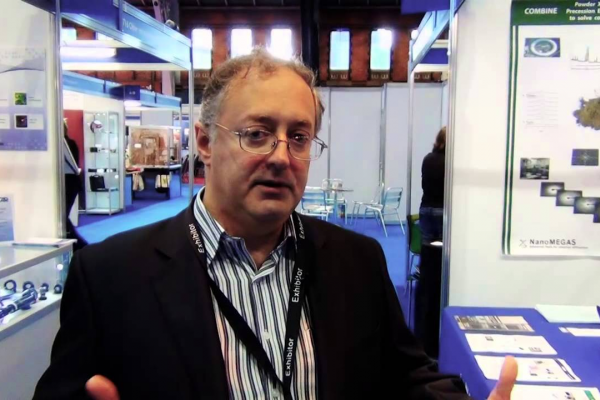ESTEEM3 interviews: Dr. Stavros Nicolopoulos from NanoMEGAS SPRL

Dr. Stavros Nicolopoulos is the Director and founder of NanoMEGAS SPRL, a leading company in advanced electron diffraction tools & applications in the field of TEM electron microscopy.
Dr. Nicolopoulos Stavros has a Materials science background with 30 years’ experience in advanced electron microscopy characterization techniques with a special focus on electron crystallography and precession electron diffraction techniques.
Moreover, he has strong experience in electron diffraction characterization of nanomaterials (orientation & phase mapping, strain mapping amorphous materials), crystal structure analysis of pharmaceutical compounds, and cultural heritage materials.
With his significant career, he has recently been nominated as Guest Editor in the MDPI journal, Symmetry. In this interview, he will explain his background and his role and views about ESTEEM.
QUESTION: Tell us a bit about yourself and your background…
“I would say a bit about my academic background. I did my bachelor in Physics in University of Thessaloniki, in Greece, from 1980 to 1984. Then, I Follow my master thesis, and doctoral thesis in University of Grenoble, in France, from 1985 to 1989. Then I had the opportunity to work in the academic field, as an associate professor in Complutense University of Madrid, up to 1996.
I have then joined the industrial sector, as application specialist. I had the proposal from Philips Electron Optics, in 1996 to join the electron microscopy field, for Spain and Portugal, I have worked for Philips first and then FEI (when FEI acquired Philips) and I have worked up to 2004.
In 2004, myself and other colleagues, we created NanoMEGAS company, based in Belgium - there were historical reasons why we did in Belgium because University of Brussels (ULB) helped us at that time with experimentations to test our first instruments. We had ideas about electronic diffraction, at that time it was very innovative ideas, specially towards precession diffractions.
Up to now, it is not a start-up, it is already a major company that works successfully in the field of electron diffraction applications for transmission electron microscope (TEM). We are about 15 people, we have more than 190 installations all over the world, more than 26 countries.
Above all, we introduce electron diffraction specifically precession electron diffraction (PED) to many laboratories. We are proud because they are more than 800 publications in this field by different scientific groups all over the world.”
QUESTION: Why did you decide to take part in the ESTEEM project?
“Our invitation date from ESTEEM2, ESTEEM3 is the last part and last 4 years.
At that time – and it is still the same today, our interest was to join a very leading team of scientists all over the world and Europe that they are leading in their sectors (EM applications, High resolution microscopy).
Our idea is that we could contribute with our own solutions, ideas for electron diffraction, in particular PED, to this consortium and to have nice synergy because of course we have learned a lot from our partners.”
QUESTION: What is your role in ESTEEM3?
“ESTEEM3 is articulating in different work packages. We are particularly active in the WP4 that it is “Imaging, diffraction and metrology”.
We contribute with our knowledge applications and we learn from the other partners about diffraction applications. For example, there are companies that work with direct detection cameras so we try to have a collaboration with these people in the sense that we can apply our applications and combine with our detectors. Also, we have partners that can benefit from our applications for their devices in order to, for example, orientation imaging or face mapping in their material.”
QUESTION: You have a special place in the ESTEEM3 consortium because you are a part of the SMEs and industrial partners. Why your role is that important?
“That is a very interesting question!
According to reliable estimations, the Electron microscopy sector worldwide supports about ten thousand jobs. High level grade all over the world and big part of this is Europe, I would say more than 40%.
The contribution of a project, like ESTEEM3, is to support the network of industries and universities that provide excellence, and they can maintain these jobs in Europe.
Why is it important ? It is not just the numbers, 10 000 or 1000 or whatever, is that by maintaining this high-end skill, you can provide next application for example, for medical imaging, you can visualise organic molecules, chemical reactions or proteins. At a large scale, you can contribute to the advance of medicine, and many advances, and maintain those high-end skills to stay in Europe.”
QUESTION: What success has already been achieved within your task? What are the most promising steps in terms of results?
“Obviously, there are many partners and many industries. I can speak for their own and they must have done a lot of achievements, every partner.
Personally, I have my own “taste”. I would just say about two that I feel that are very important and I do not want to exclude other.
For example, you can see imaging with extremely low-dose. But why it is important?
Traditionally, in electron microscopy, you can see atoms, and that was happening in the 60s and 70s. Now you can see organic molecules, we hope that someday we can see proteins. That is because you have huge applications in medicine, we can see how is organise the life, the nature for all these organic molecules. So, there have been a lot of advances thanks to ESTEEM3 contribution, from some partners.
Another achievement according to me is tomography. There was a lot of advances in imaging tomography that allow us to see in-situ reactions, we can see chemical reactions like crystal growth or dissolution of crystal during sequences. It happens ! That was not possible before.
Our aim is also there to contribute to these achievements with diffraction tomography. You can see the crystal structure of materials thanks to electron diffraction.
That would define of the achievements, but it is not the only one and there are others, like spectroscopy achievements. For my own “taste”, I will just say those two.”
QUESTION: What do you expect for the future of the project?
“We do not know if ESTEEM3 will continue, we hope that yes. It would be very important for the European industry.
I think that what will maintain is the collaboration between leading partners, for example, in our case, as a company, we have already collaboration with some selected academic partners in the Consortium. We hope and believe that this will continue besides at this end of this project, ESTEEM3.
We see that synergies make sense, with new ideas we can do many projects and all that for the benefit of the customers.
I believe, at least, smaller collaborations are there to stay.”
QUESTION : Last but not least, how SME can be better engaged/integrated in similar frameworks like ESTEEM3?
“Right now, the structure as it is, the European union not only allows but support a lot the introduction of as many possible SMEs in such Consortiums.
If you take the example of ESTEEM1, ESTEEM2 and ESTEEM3, there was progressively more companies and SMEs combined in every projects. Now in ESTEEM3, we are 5.
It is not only a question of number, of having more SMEs. It is also a question to be able to participate actively, if possible, in all activities with partners. For that, it is obviously related to budget. We are very thankful to have been supported by the budget as being an SME, with a level of 1 month/year and the project is 4 year.
I believe that if there will be a policy to support a bit more the SMEs, to have a more supported participation maybe during 2 or 3 years for 1 person during the 4 years, hopefully these synergies will be more effective between the academic players and the industry players.
That would be a “wishlist” for the future of this project.”
Interview of Dr. Stavros Nicolopoulos, Director and founder of NanoMEGAS SPRL [MP4, 177.57 MB, not barrierefree]
